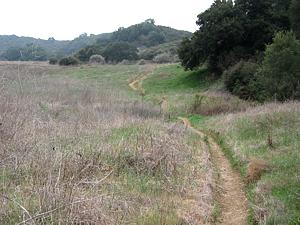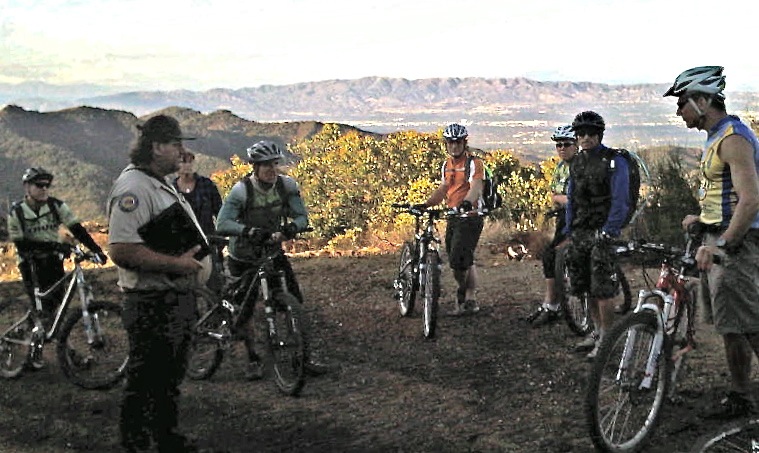On July 28, Jim Hasenauer and Jeff Klinger attended the second General Plan Meeting for Topanga State Park. It is important that riders weigh-in on this process and view the planning website at: http://www.parks.ca.gov/default.asp?page_id=25956.
Most of this meeting focused on the vision for the park and the idea of management zones. There are several important concerns for cyclists. Input at this phase of the General Plan process will be used to formulate the Preferred Plan. Please read the following, check out the website and comment at: enviro@parks.ca.gov
1. The plan emphasizes preservation of Topanga’s significant natural resources. We support that. Unfortunately, the vision does not give strong enough commitment to trail recreation in the park. The mission of California State Parks is: To provide for the health, inspiration and education of the people of California by helping to preserve the state’s extraordinary biological diversity, protecting its most valued natural and cultural resources, and creating opportunities for high-quality outdoor recreation. Topanga’s vision needs to be consistent with the agency’s mission. The Vision should include a statement such as: “Provide outstanding sustainable and diverse trail experiences for hikers, mountain bicyclists, equestrians and other park visitors.”
2. Mountain bicyclists have enjoyed Topanga since the very first days of our sport. One of the early mountain bike pioneers, Victor Vincente of America, developed his prototype “Topanga” mountain bike there. When CORBA was formed in 1987, it was partially in response to the closing of singletracks in Topanga State Park. Mountain bicyclists want equity of trail experiences, diversity of trail experiences, and connectivity of trails. The plan will influence each of these for many years, so it’s important that you submit comments now.
Equity of trail experience – If you ride Topanga, you know that on any given day, most of the trail users are on bicycles. In contrast, we’re only allowed on less than half the trails/roads. All singletracks, with the exception of Roger’s Road, are closed to us. It’s fine to have one or two singletracks “hiker only,” but it is not fair to have all but one of them closed. An early descriptive statement on the Planning web page says “singletrack trails host hikers and sometimes equestrians.” It’s time for this to change. Let the Park Service know which singletrack trails would be important to you. Ask them to open them. Another concern is that the park is considering “natural and cultural preserves.” In most cases, preserves ban bicycles. We are, of course, committed to protecting these wild and significant areas, but there should be bicycle access to and through these preserves.
Diversity of Trail Experience—Mountain bicyclists, like other outdoor recreationalists, are diverse in our interests and abilities. Topanga riders range from beginners, including children first learning to ride, to skilled, technical, even professional riders. The one size fits all view of “fire roads yes/singletracks no,” does not serve the public’s recreational needs. Our highest priority for the Santa Monica Mountains has always been access to the entire length of the Backbone Trail. In Topanga, Hondo Canyon and the Musch trail are sections of the Backbone that mountain bikers want open. In the planning meeting, they presented a “Visitor Based Camping and Trail Map” that shows the Hondo Canyon section of the Backbone open to bikes. We need to support that. It is true that not everyone could ride all of the Hondo Canyon trail without walking, but that doesn’t mean it should be closed to us. In fact, part of the experience of mountain biking is the adventure of exploring new trails and to hop off and hike-a-bike sections that are too steep or technical for our abilities. Land managers don’t seem to understand this concept, or mountain bikers in general. The Musch Trail is a significant missing link in all of their plans. There’s a trail camp there, which we need access to. The Backbone Trail is the most significant, long distance trail in the Santa Monicas. It should be open to us. The Plan also envisions a major trailhead for the Coastal Slope Trail, a long distance trail on the ocean side slope of the mountains. This too must be multiple-use.
Connectivity of trails – There are at least two major obstacles to connectivity in Topanga. The first is the cyclist missing link to the Backbone mentioned above. The second is bike access to Temescal Canyon. Over the last several years, Temescal Canyon has become the site of regular meetings, seminars, interpretive events, family activities, etc. Those of us coming from the San Fernando Valley side cannot get there by bike. That’s particularly frustrating because there are two trails that go from Topanga State Park to Temescal and one trail that goes from Will Rogers State Park to Temescal. All three of these are closed to us. The Visitor Based map indicates that the Temescal Ridge Trail would be open to bikes. This is significant and needs to be supported.
Vehicles on dirt Mulholland – State Parks is considering allowing cars to drive along dirt Mulholland in the Mulholland Corridor Zone (see map). We oppose this. Note that it does not have to be either “visitor based” or “preservation based,” it can be a mix of both.
It’s important that you let State Park officials know that you love Topanga State Park and have specific recreational needs there. We have seen the Angeles District of State Parks spend tax dollars on new “No Bikes” signage in Topanga and we’ve seen their employees attempt to re-designate Sin Nombre and two Foxes trails in Pt. Mugu to hiker-only (which CORBA literally caught in the act and prevented). Overall, they APPEAR to be biased against, and turning a blind-eye to the needs of the State’s residents who visit and recreate at State Parks via mountain bicycle. Well, State Parks is reaching out to the public for input and support. Let them know that you, as a State Parks visitor, supporter, and enthusiast, expect more from them, and equitable representation in this plan. Email comments to: enviro@parks.ca.gov or write: SOUTHERN SERVICE CENTER / Project Lead, 8885 Rio San Diego Dr., #270, San Diego, CA 92108-1627
Thanks,
Jim Hasenauer & Jeff Klinger







